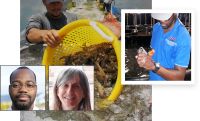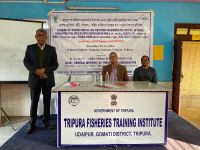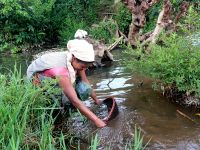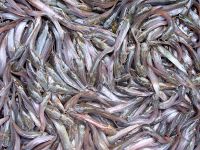In this issue:
- Promoting farmed shrimp consumption in India’s domestic market: A step towards sustainability
- Leveraging indigenous minor carp for sustainable aquaculture in Northeast India
- Shaping the future of Indian aquaculture: A path to captive catfish seed success
- Sustainable freshwater snail farming: Advancing nutrition security and rural livelihoods in Northeast India
- Promotion and protection of small fish species through farming: An initiative in Tripura
- NACA Newsletter
PORTSMOUTH, NH: Shrimp experts from around the world will gather in Bali this June for the third annual TCRS Shrimp Summit—a one-of-a-kind event that explores the issues impacting the industry's health and future, from the pond to the market. The summit is unique not just because it represents the full value chain, including major buyers, but because it spotlights the topics, both technical and tactical, that are driving change.
This year's Summit, which takes place 22-25 June, 2025, introduces several new sessions that demonstrate the event's role as a singular forum for investigating the issues that matter.
One such issue is Shrimp Welfare, particularly the use of eyestalk ablation for rapid egg production. Dr. Simão Zacarias, one of the session speakers and a recipient of the 2020 Global Aquaculture Innovation Award, says that, "although eyestalk ablation can boost egg production, it is also associated with female broodstock stress, physiological imbalance, mortality, and compromised diseas resistance in offspring."
Small indigenous fish species (SIS) are a rich source of essential nutrients, including proteins, vitamins, and minerals, making them a vital component of rural diets. Despite their nutritional significance, SIS are often undervalued and excluded from aquaculture in favor of larger commercial species.
This study highlights an initiative by ICAR-CIFA in Tripura to promote and protect small fish species through sustainable farming practices. Training programs were conducted to educate local farmers on breeding, feeding, and rearing techniques tailored to SIS. Live food production was emphasised to improve larval survival rates, and mixed-species culture strategies were developed to enhance production efficiency. The initiative demonstrated that small fish farming is a viable livelihood option, particularly in backyard water bodies, providing food security, income generation, and biodiversity conservation.
Northeast India faces significant nutrition security challenges, particularly in rural and tribal areas, where high stunting and anemia rates persist despite high per capita caloric intake. This article explores sustainable freshwater snail farming as a viable solution to address these nutritional deficiencies while enhancing rural livelihoods.
Freshwater snails, such as Pila globosa, Bellamya bengalensis, and Brotia costula, offer high protein content and essential minerals, particularly calcium and iron. Their nutritional value surpasses many plant-based protein sources and compares well with traditional livestock products. The study outlines three practical snail farming systems suited to different farming conditions. Economic analysis reveals that a small-scale backyard system can generate up to 1,800 kg of snails annually, yielding a 272% return on investment within five months. With proper training, infrastructure, and market linkages, freshwater snail farming can play a useful role in improving food security, economic resilience, and rural development in Northeast India.
Indian aquaculture has expanded beyond major carps to include diverse species such as catfish, driven by high consumer demand for their taste, soft flesh, and live marketability. However, the sector faces a major challenge: the lack of captive seed production. Relying on wild seed collection is unsustainable, necessitating the development of controlled breeding techniques. This article provides an overview of induced breeding and seed production methods for key catfish species, including Clarias batrachus, Heteropneustes fossilis, Wallago attu, Ompok spp., Mystus cavasius, Rita chrysea, Horabagrus brachysoma, and Pangasius pangasius. By adopting these techniques, Indian fish farmers can enhance catfish seed availability, supporting the government’s push for aquaculture diversification. Sustainable captive breeding will reduce pressure on wild populations while ensuring a reliable supply of high-quality catfish seed for commercial farming.










